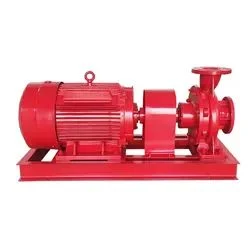Key Aspects of Chemical Pumps
2024-06-07
Chemical pumps are specifically designed to handle the transfer of corrosive, abrasive, or hazardous chemicals safely and efficiently. These pumps are constructed using materials that are resistant to chemical corrosion, ensuring the integrity of the pump and preventing contamination of the fluid being pumped. Here are some key aspects of chemical pumps:
1. Material Selection: Chemical pumps are typically constructed from materials such as stainless steel, high-grade plastics (e.g., polypropylene, polyvinyl chloride), fluoropolymers (e.g., PTFE, PVDF), and exotic alloys (e.g., Hastelloy, titanium) that are resistant to corrosion and chemical attack. The choice of materials depends on the specific chemicals being pumped and the operating conditions.
2. Sealing Mechanisms: Chemical pumps feature robust sealing mechanisms to prevent leakage of hazardous or corrosive fluids. Mechanical seals, magnetic couplings, and sealless designs are commonly used to ensure reliable and leak-free operation.
3. Chemical Compatibility: Chemical pumps are designed to handle a wide range of chemicals, acids, solvents, and aggressive fluids commonly encountered in industrial processes. They are engineered to withstand exposure to corrosive substances without degradation or failure.
4. Pump Types: Chemical pumps come in various types and configurations to suit different applications and operating conditions. Common types of chemical pumps include centrifugal pumps, diaphragm pumps, peristaltic pumps, magnetic drive pumps, and air-operated double diaphragm (AODD) pumps.
5. Centrifugal Chemical Pumps: Centrifugal chemical pumps use an impeller to impart kinetic energy to the fluid, creating centrifugal force that pushes the fluid outward. They are suitable for transferring corrosive liquids with low to medium viscosity and are commonly used in chemical processing, wastewater treatment, and water treatment applications.
6. Diaphragm Chemical Pumps: Diaphragm chemical pumps use a flexible diaphragm to create a pumping action that moves fluid through the pump. They offer excellent resistance to chemical corrosion and are ideal for handling abrasive or viscous fluids, as well as volatile or toxic chemicals.
7. Magnetic Drive Chemical Pumps: Magnetic drive chemical pumps use magnetic coupling to transfer torque from the motor to the pump impeller without the need for a mechanical seal. This design eliminates the risk of leakage and provides reliable containment of hazardous fluids.
8. Peristaltic Chemical Pumps: Peristaltic chemical pumps use a rotating roller or shoe to compress a flexible tube, creating a pumping action that moves fluid through the tube. They offer gentle handling of shear-sensitive fluids and are suitable for metering and dosing applications in pharmaceutical, food and beverage, and laboratory settings.
9. Safety Features: Chemical pumps may include safety features such as leak detection sensors, overload protection, and emergency shutdown systems to prevent accidents and ensure operator safety in hazardous environments.
10. Compliance with Standards: Chemical pumps are designed and manufactured to comply with industry standards and regulations governing the handling of hazardous chemicals and fluids, such as ANSI, API, ISO, and ATEX standards.
Overall, chemical pumps play a critical role in safely transferring corrosive, abrasive, and hazardous chemicals in various industrial processes, ensuring the integrity of the fluid being pumped and protecting equipment and personnel from exposure to harmful substances.



